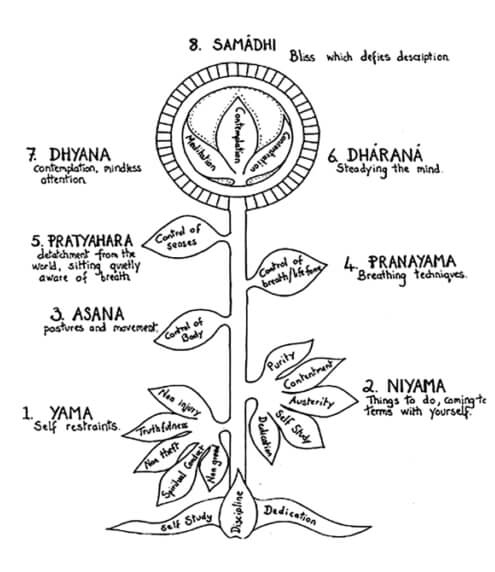In last few decades, the word “Yoga” has been used to refer to practise of performing physical postures or Asanas, with the goal of physical fitness. However in actuality, Yoga is a complete system, of which the postures are a small, though quite useful part. “The Father of Yoga”, Maharishi Patanjali compiled and refined various aspects of Yoga systematically in his “Yoga Sutras” (aphorisms). He advocated the eight folds path of Yoga, popularly known as “Ashtanga Yoga” or “The Eight limbs of Yoga” for all-round development of human beings. The eight limbs of Yoga include:
- Yama (social ethics),
- Niyama (personal ethics),
- Asana (postures),
- Pranayama (life force),
- Pratyahara (turning the senses inwards),
- Dharana (one-pointed focus),
- Dhyana (meditation),
- Samadhi (merging with the self).
1. Yama
- Signifies restraints.
- Yama, deals with one’s ethical standards and sense of integrity, focusing on our behavior and how we conduct ourselves in life
- Yoga-sutra states 5 code of conducts:
- Ahimsa: nonviolence
- Satya: truthfulness
- Asteya: nonstealing
- Brahmacharya: continence
- Aparigraha: non-possessiveness
2. Niyama
- Signifies observations
- The five niyamas are:
- Saucha: cleanliness
- Santosh: contentment
- Tapa: heat; spiritual austerities
- Svadhyaya: study of the sacred scriptures and of one’s self
- Isvara pranidhana: surrender to God
3. Asana
- Asana is the third step in the eight rungs of yoga and signifies postures.
- “Sthira sukham asanam“ – Asana is a yoga pose that is steady and comfortable.
- Yoga Asanas or Yoga Poses can be meditative poses or they can be postures aimed towards attaining strength, balance and steadiness.
- Types of Asanas:
- Cultural or Corrective Asanas: Bring out changes in the body by correcting postural defects, improper muscle tone etc. Example: Chakrasan, Dhanurasan. Cultural asanas can further be classified into two groups, depending on the effects produced:
- (i) Asanas that work through and on the spine and visceral organs.
- (ii) Asanas that work through the skeletal muscles, ligaments and joints.
- Relaxative Asanas: The asanas for relaxation are designed in a way that there is no need to contract any muscle. With these, body can come to a deep relaxation. Example: Shavasana and makarasana
- Mediative Asanas: They provide a stable seat for meditation without moving any part of your body. These postures increase concentration power and help in meditation. Example: Padmasana, Siddhasana, Swastikasana or Sukhasana.
- Cultural or Corrective Asanas: Bring out changes in the body by correcting postural defects, improper muscle tone etc. Example: Chakrasan, Dhanurasan. Cultural asanas can further be classified into two groups, depending on the effects produced:
4. Pranayama
- Signifies breath-control.
- Consists of developing awareness of one’s breathing followed by willful regulation of respiration as the functional or vital basis of one’s existence. It helps in developing awareness of one’s mind and helps to establish control over the mind.
- Pranayama has three phases:
- Puraka or Inhalation
- Khumbhaka or Retaining the Breath
- Rechaka or Exhalation
5. Pratyahara
- Signifies withdrawal of senses.
- Pratyāhāra indicates dissociation of one’s consciousness (withdrawal) from the sense organs, which connect with the external objects.
- Introspection, studying good books are some practices which can help in pratyahara.
6. Dharana
- Signifies concentration.
- Dharana indicates broad based field of attention (inside the body and mind), which is usually understood as concentration.
7. Dhyana
- Stands for meditation.
8. Samadhi
- Signifies integration
- It is the state of pure bliss.
Alternatively, these Ashtanga (literally 8 limbs), have also been described as parts of tree. Where:
- Yama is Roots
- Niyama is Trunk
- Asana is Branches
- Pranayama is Leaf/Leaves
- Pratyahara is Bark
- Dharana is Twigs/Plant
- Dhyana is Flower
- Samadhi is Fruit

The Eight Limbs of Yoga are believed to have a potential for improvement of physical health by enhancing circulation of oxygenated blood in the body, retraining the sense organs thereby inducing tranquility and serenity of mind. The practice of Yoga prevents psychosomatic disorders and improves an individual’s resistance and ability to endure stressful situations.

